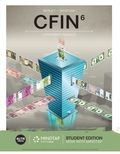
EBK CFIN
6th Edition
ISBN: 9781337671743
Author: BESLEY
Publisher: CENGAGE LEARNING - CONSIGNMENT
expand_more
expand_more
format_list_bulleted
Concept explainers
Question
Chapter 8, Problem 14PROB
Summary Introduction
Here,
The cost of equity or required rate of return is “r”.
The risk-free rate is “
The risk premium is “
The market return is “
The beta coefficient is “
The risk-free rate is 3%, risk premium is 6%, and beta coefficient is 1.5.
Expert Solution & Answer
Want to see the full answer?
Check out a sample textbook solution
Students have asked these similar questions
The risk-free rate is 5.6%, the market risk premium is 8.5%, and the stock’s beta is 2.27. What is the required rate of return on the stock, E(Ri)?
Use the CAPM equation.
The current risk-free rate of return, rRF, is 2 percent and the market risk premium, RPM, is 8 percent. If the beta coefficient associated with a firm's stock is 1.4, what should be the stock's required rate of return? Round your answer to one decimal place.
_______ ´%
The current risk-free rate of return is 2.5 percent and the market risk premium is 5 percent. If the beta coefficient associated with a firm's stock is 0.8, what should be the stock's required rate of return?
Knowledge Booster
Learn more about
Need a deep-dive on the concept behind this application? Look no further. Learn more about this topic, finance and related others by exploring similar questions and additional content below.Similar questions
- Assume that the risk-free and rate is 5.50% and the market risk premium is 7.75%. What is the expected return for the overall stock market (rm)?arrow_forwardThe risk-free rate is 5.6%, the market risk premium is 8.5%, and the stock's beta is 2.27. What is the required rate of return on the stock, E(Ri)?arrow_forwardHow do you find the market risk premium and market expected return given the expected return of stock, beta, and risk free rate? Example: The expected return of a stock with a beta of 1.2 is 16.2%. Calculate the market risk premium and the market expected return, given a risk-free rate of 3%.arrow_forward
- (d) Suppose the risk-free rate is 4%, the market risk premium is 15% and the betas for stocks X and Y are 1.2 and 0.2 respectively. Using the CAPM model, estimate the required rates of return of Stock X and Stock Y. (e) Given the results above, are Stocks X and Y overpriced or underpriced? Explain.arrow_forwardAssume that the risk-free rate is 2.8 percent, and that the market risk premium is 4.8 percent. If a stock has a required rate of return of 16.1 percent, what is its beta? Your Answer: Answerarrow_forwardSuppose the risk free rate is 2, 32%, the expected return of the market portfolio is 5, 64% and the beta of stock X-Bros S. A. is 1. 10. What is the expected cost of equity of X-Bros S. A. (in percent)?arrow_forward
- Assume that the risk-free rate is 3.5% andthe market risk premium is 4%. What is the required return for the overall stock market?What is the required rate of return on a stock with a beta of 0.8?arrow_forward(d) Suppose the risk-free rate is 4%, the market risk premium is 15% and the betas for stocks X and Y are 1.2 and 0.2 respectively. Using the CAPM model, estimate the required rates ofreturn of Stock X and Stock Y. (e) Given the results above, are Stocks X and Y overpriced or underpriced? Explain.arrow_forwardSuppose risk-free rate of return = 2%, market return = 7%, and Stock B’s return = 11%. a. Calculate Stock B’s beta. b. If Stock B’s beta were 0.80, what would be its new rate of return?arrow_forward
- Assume that the risk-free rate of return is 4% and the market risk premium (i.e., Rm - Rf) is 8%. If use the Capital Asset Pricing Model (CAPM) to estimate the expected rate of return on a stock with a beta of 1.28, then this stock's expected return should be -- A) 10.53% B) 14.24% 23.15% 6.59%arrow_forwardAssume the following information about the market and Lithium Motors Stock. Lithium's beta = 1.80, the risk−free rate is 2.50%, the market risk premium is 8.0%. Using the SML, what is the expected return for the firm's stock?arrow_forwardSuppose risk-free rate of return = 2%, market return = 7%, and Stock B’s return = 11%. Calcuate Stock B’s beta. If Stock B’s beta were 0.80, what would be its new rate of return?arrow_forward
arrow_back_ios
SEE MORE QUESTIONS
arrow_forward_ios
Recommended textbooks for you
 Intermediate Financial Management (MindTap Course...FinanceISBN:9781337395083Author:Eugene F. Brigham, Phillip R. DavesPublisher:Cengage Learning
Intermediate Financial Management (MindTap Course...FinanceISBN:9781337395083Author:Eugene F. Brigham, Phillip R. DavesPublisher:Cengage Learning

Intermediate Financial Management (MindTap Course...
Finance
ISBN:9781337395083
Author:Eugene F. Brigham, Phillip R. Daves
Publisher:Cengage Learning
Portfolio return, variance, standard deviation; Author: MyFinanceTeacher;https://www.youtube.com/watch?v=RWT0kx36vZE;License: Standard YouTube License, CC-BY